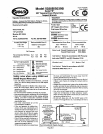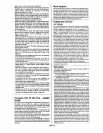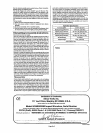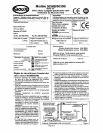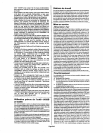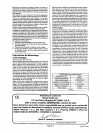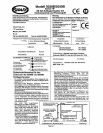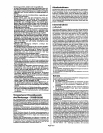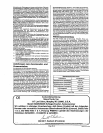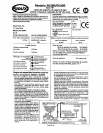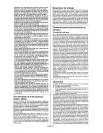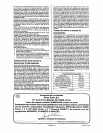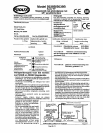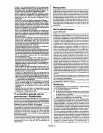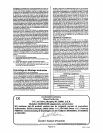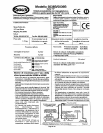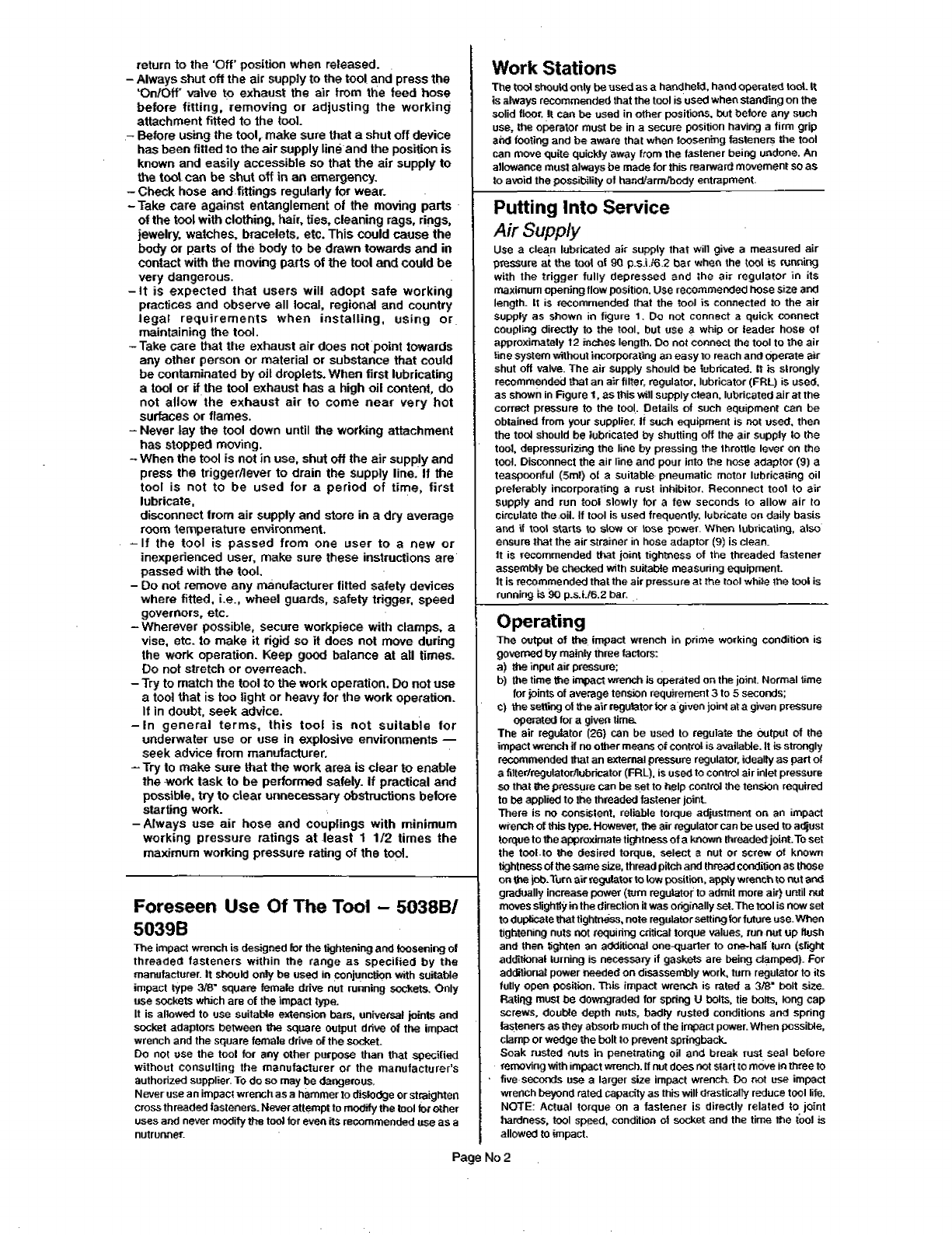
return
to
the
'Off'
position when released.
-Always
shut
off
the
air
supply
to
the
tool
and
press
the
'OntOff'
valve
to
exhaust
the
air
from
the
feed
hose
before
fitting,
removing
or
adjusting the working
attachment fitted
to
the
tool.
-Before
using
the
tool,
make
sure
that
a
shut
off
device
has
been
fitted
to
the
air
supply line
and
the
position
is
known and
easily
accessible
so
that
the
air supply to
the
tool
can
be
shut
off in
an
emergency.
-Check
hose
and
fittings
regularly
for
wear-
-Take
care against entanglement
of
the
moving
parts
of
the tool with
clothing,
hair,
ties,
cleaning
rags,
rings,
jewelry,
watches,
bracelets,
etc.
This
could
cause
the
body
or
parts
of
the
body
to
be
drawn towards
and
in
contact
with
the
moving
parts
of
the
tool
and
could
be
very dangerous.
-It
is
expected that users will
adopt
safe
working
practices
and observe all
local,
regional
and
country
legal
requirements
when
installing,
using
or
maintaining the
tool.
-Take
care
that
the
exhaust
air
does
not
point
towards
any
other person or material
or
substance
that
could
be
contaminated
by
oil
droplets.
When first lubricating
a
tool
or
if
the
tool
exhaust
has
a
high
oil
content,
do
not
allow
the
exhaust
air
to
come
near
very
hot
surfaces
or
flames.
Never
lay
the
tool
down
until
the
working
attachment
has
stopped
moving.
-When
the
tool
is
no?
in
use,
shut
off
the air
supply
and
press the triggerflever
to
drain the
supply
line.
If
the
toot
is
not
to
be
used
for
a
period
of
time,
first
lubricate,
disconnect
from air
supply
and
store
in
a
dry
average
room
temperature
environment.
-If the tool
is
passed
from
one
user
to
a
new
or
inexperienced
user,
make
sure
these instructions are
passed
with
the
tool.
-
Do
not remove
any
manufacturer fitted
safety
devices
where
fitted,
i.e.,
wheel
guards,
safety
trigger,
speed
governors,
etc.
-Wherever
possible,
secure
workplace
with
clamps,
a
vise, etc.
to
make
it
rigid
so
it
does
not
move
during
the
work operation.
Keep
good
balance
at
all
times.
Do
not
stretch
or
overreach.
-Try
to
match
the
too!
to
the
work
operation.
Do
not
use
a
tool
that
is
too
light
or
heavy
for the work
operation.
If
in
doubt,
seek
advice.
-in general
terms,
this
too!
is
not suitable
for
underwater
use
or
use
in
explosive
environments
-
seek
advice
from
manufacturer.
-Try to
make
sure
that
the
work
area
is dear
to
enable
the
work
task to
be
performed
safely.
If
practical
and
possible,
try
to
clear
unnecessary
obstructions
before
starting
work.
-Always
use
air
hose
and
couplings with minimum
working
pressure
ratings
at
least
1
112
times
the
maximum
working
pressure
rating
of
the
tool.
Foreseen
Use
Of
The
Tool
-
5038Bl
50396
The
impact wrench
is
designed
for
the tightening
and
loosening
of
threaded fasteners within the range
as
specified
by
the
manufacturer It
should
only
be
used
10
conjunction with
suitable
impact
type
318'
square
female
drive
nut running
sockets.
Only
use
sockets
which
are
of
the impact
type.
It is allowed to use suitable extension
bars.
univefsat
joints
and
socket
adaptors between
the
square output drive
of
the
impact
wrench and the square
female
drive
oi
the socket.
Do
not
use
the tool
for
any
other purpose than that
specified
without consulting the manufacturer
or
the manufacturer's
authorized supplier
To
do
so
may
tie
dangerous,
Never
use
an impac! wrewhas
a
hammer
to dislodge or straighten
cross threaded fasteners.
Never
attempt to
modify
the
tool
fw
other
uses and never modify
the
too) for even
its
recommended
use
as
a
nutrunner
Work
Stations
-
The
tool
should
only
be
used
as
a
handheld, hand operated tool.
It
is
always
recommended that the tool
is
used
when
standing
on the
solid
floor.
It
can
be
used
in other positions. but
before
any
such
use,
the
operator
must
be
in
a
secure position having
a
firm grip
and
footing
and
be
aware that
when
loosening
fasteners
the
tool
can
move quite quickty
away
from
the fastener being undone. An
allowance must
always
be
made
for this rearward movement
so
as
to
avoid
the oossibilitv
of
hand/arm/bodv entrapment.
-
Page
Putting
Into
Service
-
No
2
Air
Supply
Use
a
clean lubricated
air
supply
that will give
a
measured air
pressure
at
the
tool
of
90
p.s.i.16.2
tsar when the tool
is
running
with
the trigger fully depressed and the air regulator in its
maximum opening flow position. Use recommerided hose
size
and
length.
1;
is recommended that the tool
is
connected to the air
supply as
shown
in figure
1.
Do
not
connect
a
quick
connect
coupling directly to
the
8001,
but
use
a
whip or leader hose
of
approximtely
12
inches length.
Do
not connect the tool to the air
line
system
without incorporating
an
easy
to reach
and
operate air
shut off valve. The air supply should
be
lubricated.
It
is
strongly
recommended
that
an air filter, regulator, lubricator
(FRL)
is used,
as
shown
in Figure
1,
as
this will supply
clean,
lubricated airat the
correct
pressure to the tool. Details of such equipment
can
be
obtained
from
your
supplier.
If
such
equipment is not
used.
then
the tool should
be
lubricated
by
shutting
off
the air
supply
40
the
tool, depressurizing the line
by
pressing
the
ihronle lever on the
too). Disconnect the air line and pour into
the
hose
adaptor
(9)
a
teaspoonful
(5ml)
of
a
suitable pneumatic motor lubricating oil
preferably incorporating
a
rust inhibitor. Reconnect tool
to
air
supply and run
tool
slowly
for
a
few seconds to allow air to
circulate the oil.
If
tool is used frequently, lubricate
on
daily
basis
and
if
tool
starts
to
slow
or
lose power.
When
lubricating, also
ensure
that the air strainer in hose adaptor
(9)
is clean.
It is
recommended
that joint tightness of
the
threaded fastener
assembly
be
checked
with suitabie
measuring
equipment.
It is recommended that the air pressure
a!
the
tool
while
the
tool
is
running
is
90
p.s.i./6.2
bar.
Operating
The
output
of
the
impact
wench in prime working condition is
governed
by
mainly three factors:
a)
the
input
air
pressure;
b)
the
time
the
impact
wrench
is
operated
on
the joint. Normal
time
for
joints of average tension requirement
3
to
5
seconds;
c)
the
selling
of
the
air
regulator
for
a
given joint
at
a
given pressure
operated
for a
given time.
The
air regulator
(26)
can
be
used
to regulate the output of the
impact
wench
if
no
other
means
of
control is available.
It
is
strongly
rmmded that
an
external
pressure
regulator, ideally
as
part
of
a
filter/rqulator/ltibricator
(FRL).
is
used
to control air inlet pressure
so
that
the
pressure
can
be
set to help control the tension required
to
he
applied
to
Ihe
threaded fastener
joint
There is
no
consistent. reliable torque adjustment
on
an
impact
wrench
of
this
type.
However,
the
air regulator
can
be
used
to
adjust
torque
to theapproximate tightnessof
a
known
threadedjoint.Toset
the toolto
the
desired torque, select
a
nut or
screw
of
known
tightness
of
the
same
size,
thread
pitch
and
thread
condition
as
those
on
(tie
job.Turn
air
regulator
to
low
position,
apply
wrench
$0
nut
and
gradually increase
power
(turn
regulator
to
admit
more
air) until
nut
moves
slightly
if!
the direction it
was
originally
set.The
tool is
now
set
to duplicatethat tigMness,
note
regulatorsetting for future use.When
tightening nuts
not
requiring critical torque values,
run
nut
up
Hush
and then
tighten
an
additional
one-quarter to
one-half
turn
(sBght
additfonal turning is necessary if gaskets are being
damped).
For
additional power
needed
on
disassembly work, turn regulator to its
fully open position.
This
impact
wrencti
is
rated
a
3/8"
bolt
size.
Rating must
be
downgraded
far
spring
U
bolts, tie
bolts,
long
cap
screws, double depth
nuts,
badly
rusted conditions
and
spring
fastenersas
they
absorb
much of the impact power. When possible,
clamp
or wedge
the
bolt
to
prevent
springback.
Soak
rusted nuts
in
penetrating oil
and
break rust seal before
removing
with
impact wrench.
tf
mt
does
rat start
to
move
in
three
to
five
seconds
use
a
larger
size
impact wrench.
Do
not
use
impact
wrench
beyond rated
capacity
as
this will drastically reduce tool life.
NOTE:
Actual torque on a fastener is directly related
to
joint
hardness, tool
speed,
condition
of
socket
and the time
me
tool
is
allowed
to
impact.



